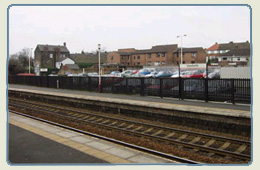


 






|

Taxonomy and description
Terminology
Types of New Rail Station
Technology

New rail stations provide new places for people to board and alight trains
and, hence, increase the geographical accessibility of the rail network.
They have a number of objectives, including to reduce road congestion
through the diversion of car journeys to rail, to increase travel choices
and to generate increased revenue through increased rail-use.
Terminology
New rail stations refers to new stations on existing heavy, or conventional,
railway lines. New stations built as part of a new heavy, or conventional,
railway line or system, and the provision of light rail are covered in
separate sections new rail infrastructure and lines
and to light rail.
Types of New Rail Station
It is helpful to distinguish between four different types of new rail
station:
- New stations on existing local, suburban lines - it may be possible
to identify sites for new stations on existing railway lines as they
pass through the suburbs and hinterland of a particular urban area.
Such stations will generally have one platform in each direction - for
example, one platform for travel into the centre of the urban area and
one platform for travel back out of, or away from, the centre of the
urban area. If space allows, a car park may be built adjacent to new
rail stations, providing travellers with the opportunity for park
and ride; such car-parking provision will often be relatively
limited other than at certain key stations which are situated close
to major road connections.
- New interchange stations on existing lines - in dense urban areas
where there are several railway lines which cross each other in different
places, or where there is a network of inter-connecting bus routes,
there may be opportunities to site new rail stations at the junction
of two or more railway lines or bus routes, providing travellers with
the opportunity to interchange between the different services. Where
they are situated on the junction of two railway lines, stations will
have several platforms to provide for interchange between the different
lines. These such stations are covered in greater detail in a separate
section terminals and interchanges. Again,
where space allows, provision may be made for park
and ride.
- New strategic park and ride, or parkway, stations on existing inter-city
lines - there may be opportunities to site new rail stations at the
edges of urban areas on existing inter-city railway lines, to serve
as a large scale park and ride facility for access to the centre of
the urban area. The station itself may be relatively small, with one
platform in each direction, but would have a large car park with good
road access serving a wide catchment area, for example adjacent to a
motorway junction. These such stations are covered in greater detail
in a separate section park and ride.
- New stations on new lines - where a new railway line or system is
built it will, naturally, be associated with the building of one or,
more generally, a series of new rail stations. The nature of these stations
will depend largely on the nature of the new line or system of which
it is part. New rail lines and systems, and the new rail stations associated
with them, are covered in a separate section new
rail infrastructure and lines.
Technology
There are a wide range of design features which will need to be considered
in connection with the building of a new rail station. Overall station
designs range from the basic halt, with a platform for both directions,
through stations with more developed waiting and ticketing facilities,
up to the higher specification, staff stations. More detailed considerations
include:
- The need to comply with local topographical constraints - that is
whether the lie of the land and the alignment of the railway line mean
that the station needs to be below or above, as opposed to at, street
level;
- The need to comply with local space constraints - that is whether
development density in the area means that the station needs to be below
ground;
- the method of crossing from one platform to another - the main three
options being level crossing, overbridge or underbridge/tunnel.

|




